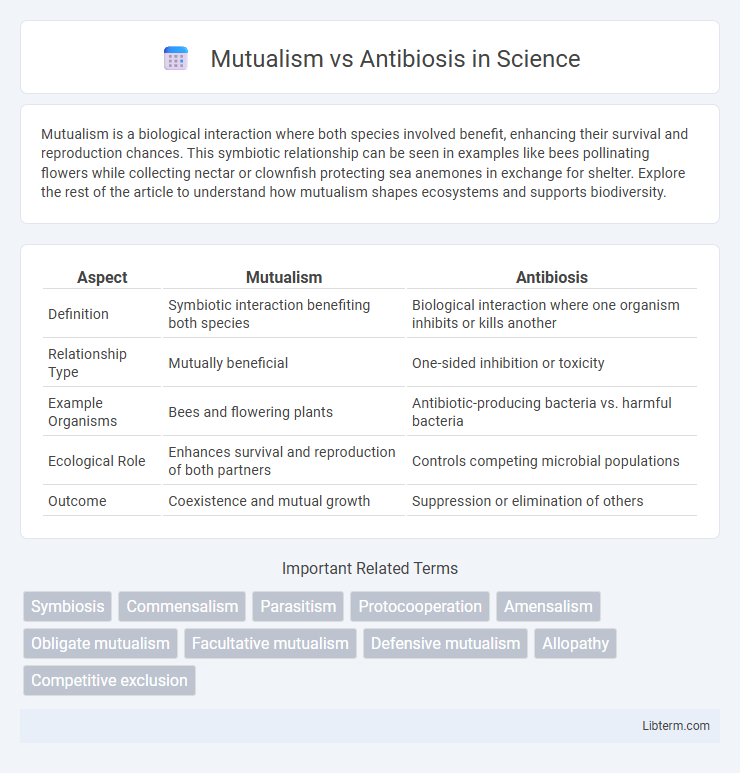Mutualism is a biological interaction where both species involved benefit, enhancing their survival and reproduction chances. This symbiotic relationship can be seen in examples like bees pollinating flowers while collecting nectar or clownfish protecting sea anemones in exchange for shelter. Explore the rest of the article to understand how mutualism shapes ecosystems and supports biodiversity.
Table of Comparison
| Aspect | Mutualism | Antibiosis |
|---|---|---|
| Definition | Symbiotic interaction benefiting both species | Biological interaction where one organism inhibits or kills another |
| Relationship Type | Mutually beneficial | One-sided inhibition or toxicity |
| Example Organisms | Bees and flowering plants | Antibiotic-producing bacteria vs. harmful bacteria |
| Ecological Role | Enhances survival and reproduction of both partners | Controls competing microbial populations |
| Outcome | Coexistence and mutual growth | Suppression or elimination of others |
Introduction to Mutualism and Antibiosis
Mutualism is a symbiotic interaction where both species involved derive benefits, enhancing their survival and reproduction, exemplified by pollination between bees and flowering plants. Antibiosis refers to a biological interaction in which one organism produces substances that inhibit or kill another, such as antibiotic production by certain bacteria to suppress competitors. Understanding these interactions highlights their ecological roles in shaping community dynamics and microbial competition.
Defining Mutualism: Key Characteristics
Mutualism is a symbiotic relationship where both species benefit from the interaction, enhancing survival and reproduction for each partner. Key characteristics of mutualism include resource exchange, mutual dependence, and co-evolution, exemplified by pollinators and flowering plants. This interaction contrasts with antibiosis, where one organism produces inhibitory substances that harm the other.
Understanding Antibiosis: Core Concepts
Antibiosis is a biological interaction where one organism produces substances that inhibit or kill another, often observed between microorganisms such as bacteria and fungi. This antagonistic relationship plays a crucial role in natural ecosystems and agricultural biocontrol, as it can suppress pathogens and promote plant health. Understanding the molecular mechanisms of antibiosis enables advances in developing antibiotics and sustainable pest management strategies.
Types of Mutualistic Relationships
Mutualism encompasses various types of relationships, including obligate mutualism where both species depend entirely on each other for survival, and facultative mutualism where species benefit from each other but can live independently. Examples include pollination mutualism between bees and flowering plants, where bees obtain nectar while assisting plant reproduction, and gut microbiome mutualism, where bacteria aid in digestion and gain a nutrient-rich environment. These interactions contrast with antibiosis, which involves one organism producing substances harmful to another without intimate cooperation.
Forms of Antibiosis in Nature
Antibiosis in nature manifests through various forms, including antibiotic production by soil bacteria like Streptomyces that inhibit competing microbes, and the secretion of antifungal compounds by certain plants to protect against pathogens. This interaction also occurs when bacteria produce bacteriocins targeting closely related species, reducing competition within microbial communities. These mechanisms highlight antibiosis as a critical natural strategy for survival and resource allocation among microorganisms and plants.
Mutualism vs. Antibiosis: Main Differences
Mutualism and antibiosis represent distinct types of biological interactions between species, where mutualism involves a beneficial relationship for both organisms, such as pollinators and flowering plants exchanging nutrients for reproduction support. Antibiosis, on the other hand, is characterized by one organism producing substances that inhibit or kill another, commonly observed in antibiotic-producing bacteria that suppress competing microbes. The main differences lie in mutualism's reciprocal benefits versus antibiosis's antagonistic effects and chemical mediation targeting competitor suppression.
Ecological Roles and Benefits
Mutualism fosters ecological balance by enabling species to exchange resources and services, such as pollination by bees and nitrogen fixation by rhizobia in legumes, enhancing biodiversity and ecosystem productivity. Antibiosis involves organisms producing biochemicals that inhibit competitors or pathogens, playing a crucial role in controlling populations and preventing disease outbreaks. Both interactions contribute to ecosystem stability by shaping species dynamics and promoting resilience against environmental stresses.
Examples of Mutualism Across Ecosystems
Mutualism occurs when different species engage in mutually beneficial interactions, such as the relationship between clownfish and sea anemones in coral reefs, where clownfish gain protection and anemones receive cleaning and nutrients. Other examples include mycorrhizal fungi associating with plant roots across terrestrial ecosystems, enhancing nutrient absorption for plants while receiving carbohydrates. Coral reefs, tropical rainforests, and grassland ecosystems each showcase distinct mutualistic partnerships essential for biodiversity and ecosystem stability.
Case Studies of Antibiosis in Action
Antibiosis is exemplified in agricultural case studies where Streptomyces species produce antibiotics that suppress soil-borne pathogens, enhancing crop health and yield. Research on Bacillus subtilis demonstrates its ability to secrete lipopeptides inhibiting fungal growth, showcasing antibiosis as a natural biocontrol mechanism. These studies highlight antibiosis as a critical biological interaction driving microbial competition and ecological balance in diverse environments.
Importance of Mutualism and Antibiosis in Biodiversity
Mutualism enhances biodiversity by fostering cooperative interactions between species, such as pollinators and flowering plants, which improve survival and ecosystem resilience. Antibiosis, involving one species producing substances harmful to another, helps regulate populations and maintain microbial diversity, crucial for soil health and disease suppression. Both mutualism and antibiosis drive ecological balance, promoting diverse and stable habitats.
Mutualism Infographic

 libterm.com
libterm.com